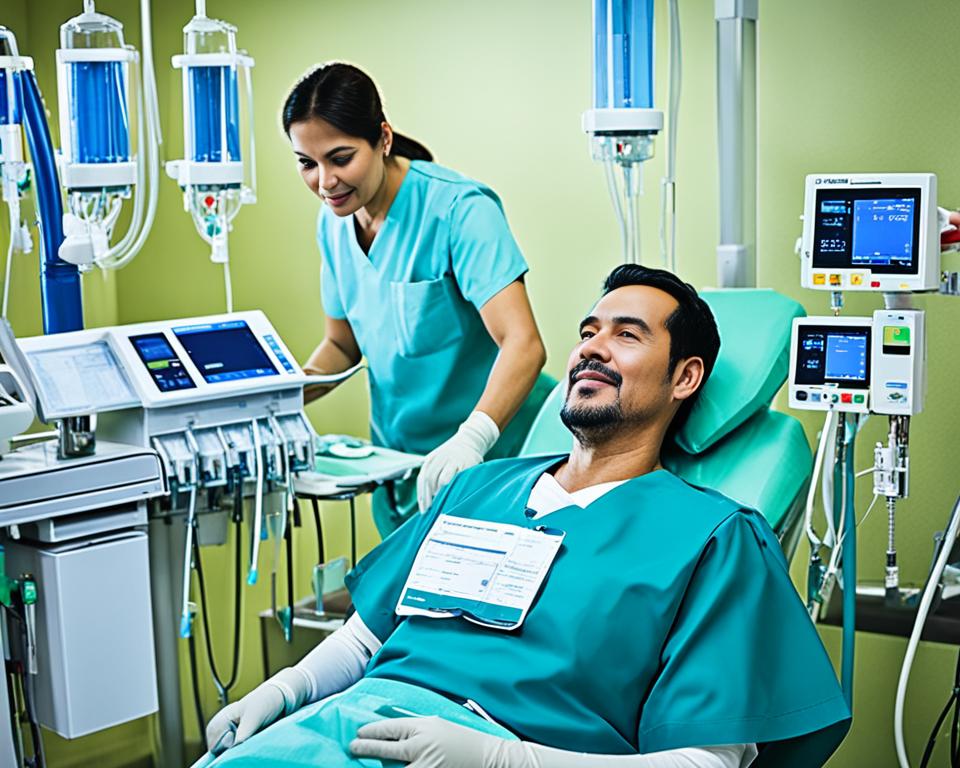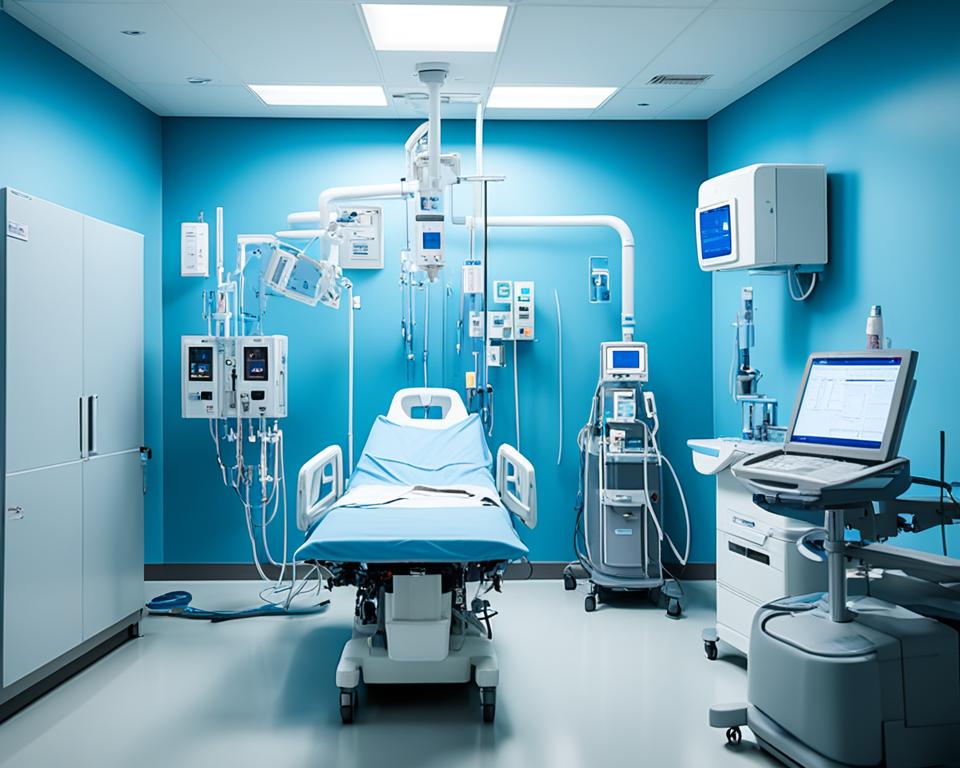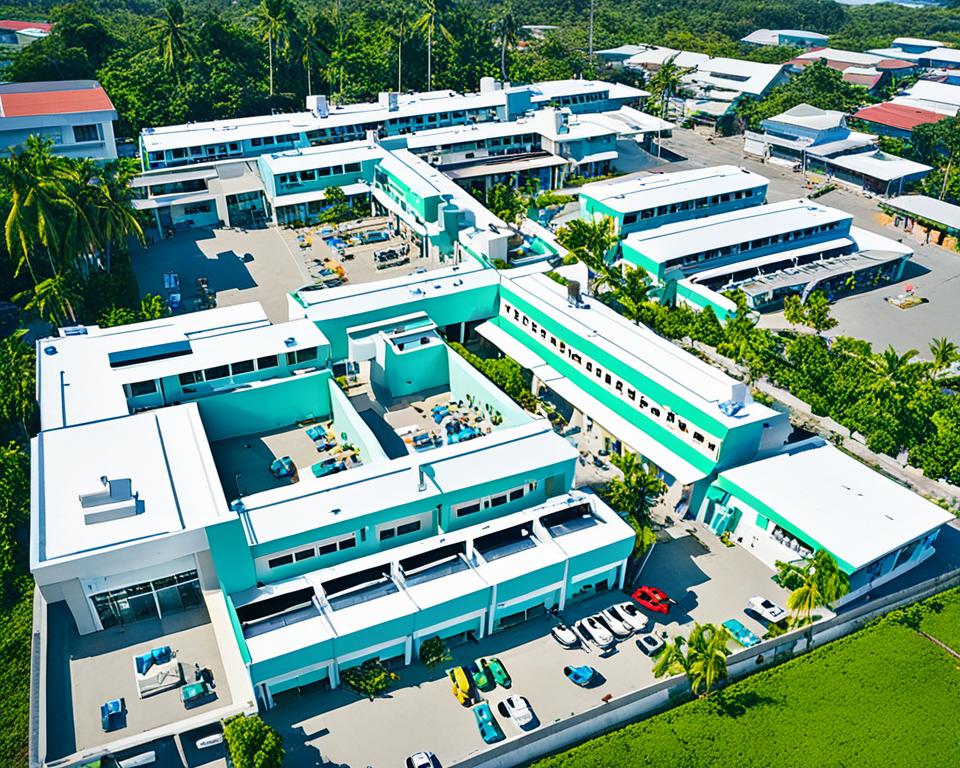
In the Philippines, many patients face a huge financial burden for their dialysis treatment. This treatment is critical for those with end-stage renal disease (ESRD). But the costs are high. This article will give a detailed look at why dialysis costs so much in the Philippines. It aims to help patients and families understand their healthcare choices better.
Read interesting things at : web-quanto
Key Takeaways
- Dialysis costs in the Philippines can vary widely depending on the type of treatment, location, and healthcare facility.
- The average cost of hemodialysis in the Philippines ranges from PHP 2,500 to PHP 5,000 per session.
- Peritoneal dialysis, including Continuous Ambulatory Peritoneal Dialysis (CAPD) and Automated Peritoneal Dialysis (APD), can cost between PHP 1,500 to PHP 3,500 per month.
- Government-funded programs and non-profit organizations offer financial assistance to help reduce the burden of dialysis costs for eligible patients.
- Careful consideration of factors like facility reputation, treatment quality, and proximity to the patient’s residence can help in choosing the right dialysis center in the Philippines.
Understanding Dialysis and Its Necessity
Dialysis saves lives by cleaning the blood when the kidneys can’t. It’s a must-have treatment in the Philippines for those with kidney failure. Knowing who needs dialysis is key to getting the right care on time.
What is Dialysis?
Dialysis takes over the job of the kidneys to clean the blood. A machine filters out waste, salt, and water. This is needed when kidney disease stops the kidneys from working well.
Who Needs Dialysis Treatment?
People with chronic or end-stage kidney disease often need dialysis. Chronic kidney disease happens slowly and can come from diabetes or high blood pressure. End-stage renal disease is when the kidneys can’t filter waste and fluids anymore.
Dialysis might also be for issues like:
- Sudden kidney problems from dehydration, infections, or some drugs
- Polycystic kidney disease, which is a genetic condition forming cysts in the kidneys
- Inflammations of kidney filters (glomeruli) from glomerulonephritis
- Lupus, an autoimmune illness that affects the kidneys
In the Philippines, dialysis is life support for these patients. It helps keep them healthy and their lives better by handling body waste and managing fluid levels.
Dialysis Treatment Options in the Philippines
In the Philippines, dialysis patients can choose from two main types: hemodialysis and peritoneal dialysis. Hemodialysis uses a machine to clean blood, while peritoneal dialysis uses the body’s own membrane. This allows people to pick what suits their health and lifestyle best.
Hemodialysis in the Philippines
For hemodialysis, a machine filters blood, taking out waste, extra water, and salt. Patients need to go to the center three times a week and spend hours there. This type works well for severe kidney problems needing more care often.
Peritoneal Dialysis in the Philippines
Peritoneal dialysis is at-home and uses the belly’s lining to clean blood. A special solution goes in and out through a tube in the belly, either by hand or with a machine. This lets people do their treatment at home every day.
Choosing between these methods in the Philippines depends on health, lifestyle, and choice. The patient’s health, other illnesses, and ability to care for themselves are key. This helps find the right treatment.
| Dialysis Treatment | Description | Frequency | Location |
|---|---|---|---|
| Hemodialysis | Blood is filtered and purified using a machine | 3 times per week | Dialysis centers |
| Peritoneal Dialysis | Dialysis solution is infused and drained through a catheter in the abdomen | Daily | Home |
When picking between hemodialysis and peritoneal dialysis in the Philippines, talking with a nephrologist is important. They can give advice tailored to your individual needs and health.
Factors Influencing Dialysis Costs in the Philippines
The cost of dialysis treatment in the Philippines can change a lot based on important factors. Knowing these factors helps patients guess their costs and make smart choices about their care.
Location and Facility Type
The place where the dialysis center is and the kind of place it is affect the treatment cost. Urban or city centers usually cost more because they have high bills and lots of people need the service. Also, private clinics may be more expensive than public hospitals because they’re privately owned.
Duration and Frequency of Treatment
How long the dialysis takes and how often it’s needed are key to the price too. More sessions or longer times mean more money. The kind of dialysis, like hemodialysis or peritoneal dialysis, also makes a difference.
For example, a patient in Manila getting hemodialysis at a private clinic might pay more than someone in a rural area. This is especially true if the rural patient can do with less sessions. These examples show how costs can vary.
Understanding these points lets patients plan for the financial side of dialysis. They can look for choices that meet their budget and medical needs. Thinking about the location, type of center, and how often treatment is required helps in making wise decisions. This way, patients can handle their dialysis expenses well.
Average Costs of Hemodialysis in the Philippines
Hemodialysis is widely used in the Philippines but can be expensive. A single session can cost from ₱2,000 to ₱5,000. This cost varies based on where the center is, its type, and the services it offers.
If someone needs dialysis often, the costs can become overwhelming. Every month, they might spend from ₱40,000 to ₱100,000. This amount could go higher with extra medical needs or special care.
Yearly costs for hemodialysis could be very high. They range from ₱480,000 to ₱1,200,000 or more. This financial load is tough for many Filipino households. Finding affordable dialysis is crucial.
| Hemodialysis Cost Factor | Average Cost Range |
|---|---|
| Single Hemodialysis Session | ₱2,000 – ₱5,000 |
| Monthly Hemodialysis Cost | ₱40,000 – ₱100,000 |
| Annual Hemodialysis Cost | ₱480,000 – ₱1,200,000+ |
These high costs stress the need to look at other dialysis methods. It’s also important to find financial help and support. This can lessen the money worries for patients and their families.
Average Costs of Peritoneal Dialysis in the Philippines
In the Philippines, besides hemodialysis, people are turning to peritoneal dialysis more often. This method allows patients to dialyze at home, giving them the freedom to keep up with their daily lives. But, the cost of peritoneal dialysis is a big factor for patients and their families to think about.
Continuous Ambulatory Peritoneal Dialysis (CAPD)
CAPD is a type of peritoneal dialysis that requires the patient to change the dialysis solution by hand, multiple times a day. Usually, in the Philippines, CAPD costs between ₱20,000 and ₱30,000 per month. The price varies based on the type of solution, how often it needs to be changed, and the patient’s health condition.
Automated Peritoneal Dialysis (APD)
With APD, a machine called a cycler takes care of the dialysis while the patient sleeps. APD in the Philippines is a bit more expensive than CAPD, costing between ₱25,000 and ₱40,000 monthly. This is because the machine and special supplies add to the total cost.
Peritoneal dialysis in the Philippines can cost differently for each patient. Things like where you live, which center you choose, and your medical conditions all affect the cost. It’s wise to talk to a healthcare provider for a precise idea of the peritoneal dialysis cost in the Philippines for you.
How Much Dialysis in Philippines Costs with Insurance
The overall cost of dialysis treatment in the Philippines is influenced by health insurance. It’s vital to know how insurance impacts dialysis cost in philippines. This helps patients find cost-effective and available treatment.
It’s crucial to know if insurance plans cover dialysis treatment in the philippines costs. In the Philippines, both government and private insurances provide some help. This reduces the financial stress on patients.
Insurance coverage varies based on the plan, terms, and one’s policy. Some plans may pay more of the dialysis cost philippines. Others might have less coverage, making patients pay more themselves.
“The availability and scope of insurance coverage can have a significant impact on the overall cost of dialysis treatment in the philippines for patients,” explains Dr. Maria Gonzalez, a leading nephrologist in the country.
When figuring out how insurance affects how much dialysis in philippines costs, look at:
- The type of insurance plan (e.g., government-sponsored, private, or employer-provided)
- The specific coverage for dialysis treatments, including any deductibles, co-payments, or maximum coverage limits
- The patient’s overall health status and any additional medical conditions that may affect their insurance coverage
By checking these points and looking at different insurance options, patients can lower their dialysis treatment in philippines costs. This ensures they get necessary care.

Dialysis Cost Assistance Programs in the Philippines
In the Philippines, some people find it hard to pay for dialysis. But, there are government and non-profit help available. These groups help lessen the cost for patients to get the kidney care they need.
Government-Funded Programs
The government in the Philippines helps pay for dialysis for those who qualify. The Philippine Health Insurance Corporation (PhilHealth) helps cover the costs. If you’re part of PhilHealth, you might get money back for your dialysis treatments, based on your plan.
The Department of Health (DOH) runs places called Malasakit Centers. These are one-stop shops for people who need help paying for medical care, including dialysis. They work with others to help those in financial need.
Non-Profit Organizations
Aside from the government, non-profits also offer financial aid for dialysis. Organizations like the Kidney Foundation of the Philippines and the National Kidney and Transplant Institute help by:
- Subsidizing dialysis costs
- Offering financial aid
- Providing educational help and support groups for patients and their families
- Suggesting good places for dialysis and medical care
To learn more about getting help with dialysis costs, contact these groups. They can tell you how to qualify and apply for aid.
Using these programs can make the cost of dialysis less daunting. People in the Philippines can get the kidney care they need to stay healthy.
Managing Dialysis Costs: Tips and Strategies
Dealing with dialysis costs in the Philippines can be hard for patients and their families. But, effective strategies can help control costs. This guide offers tips to manage your dialysis expenses better.
Budgeting and Financial Planning
Start by making a detailed budget. Figure out your monthly income and expenses. Include the costs of dialysis like medications and travel.
Knowing your financial state helps spot areas to save money. And you might find other ways to manage costs.
Seeking Financial Assistance
There are many ways to get help with dialysis costs. You can check PhilHealth coverage, social welfare, and non-profits. They might offer financial aid or subsidies for your treatment.
Negotiating with Healthcare Providers
Don’t hesitate to talk to your healthcare providers about costs. You can ask them about payment plans or if there are cheaper treatment options. Being open about your financial situation can lead to solutions within your budget.
Exploring Cost-Effective Alternatives
Looking at different treatment options can cut dialysis costs. For example, peritoneal dialysis at home might be cheaper. Also, consider using generic drugs or buying supplies in bulk to save money.
To handle dialysis costs in the Philippines, use a holistic method. Include budgeting, seeking financial help, talking to healthcare providers, and finding cheaper treatment options. This way, you can manage your dialysis costs and get the needed care.
| Budgeting and Financial Planning | Seeking Financial Assistance | Negotiating with Healthcare Providers | Exploring Cost-Effective Alternatives |
|---|---|---|---|
| – Create a detailed budget – Assess monthly income and expenses – Identify areas to cut costs |
– Explore PhilHealth coverage – Investigate social welfare programs – Seek aid from non-profit organizations |
– Ask about payment plans and discounts – Discuss alternative treatment options – Be transparent about your financial situation |
– Consider peritoneal dialysis – Look into generic medications – Purchase supplies in bulk |
Choosing the Right Dialysis Center in the Philippines
Choosing the best dialysis center in the Philippines is critical for patients. They must look at many aspects to get top care and the result they want. Things like the center’s approval and the staff’s skills are very important in dialysis quality.
Factors to Consider
When looking at dialysis centers in the Philippines, patients need to check the following:
- Facility Accreditation: Find centers approved by big names like the Philippine Health Insurance Corporation (PhilHealth) or the Department of Health (DOH). This means the center meets high-quality rules.
- Medical Staff Qualifications: Study the skills and work history of the center’s medical team. This includes kidney doctors, nurses, and technicians. They should be highly qualified to give the best care.
- Equipment and Supplies: Make sure the center has up-to-date machines and all the needed materials, like dialysate, to do the treatment well.
- Patient Satisfaction: Read what other patients have said or ask doctors for their opinion. It tells a lot about the care and how happy the patients are.
- Accessibility and Convenience: Check where the dialysis center is, its hours, and how to get there. It should fit the patient’s life and easy to reach.
- Comprehensive Care: Choose a center that looks at the patient’s whole well-being. They should care for medical, emotional, food, and social needs, not just the illness.
Thinking about these points helps patients pick the right dialysis center. This way, they ensure getting the best kidney care in the Philippines.

Dialysis Centers Philippines: Top Providers
Looking for top-notch dialysis care in the Philippines? Several dialysis centers and dialysis facilities are at the forefront. They provide top services to those needing dialysis, meeting a wide range of needs.
Makati Medical Center Dialysis Clinic is a standout. This clinic has served patients with excellent care for more than 20 years. It’s in the heart of Makati City and includes a team of top nephrologists and nurses, offering personalized attention.
The National Kidney and Transplant Institute (NKTI) in Quezon City is also well-known. It’s a leading hospital offering a variety of dialysis services. Since it’s a public hospital, it serves patients from all walks of life.
The Cebu Velez General Hospital Dialysis Center in Cebu City is highly regarded too. This high-tech facility is known for its quality care in the Visayas region. Patients benefit from the latest technology and a team of experts.
In Davao, the Southern Philippines Medical Center Dialysis Unit is a key player. It is known for its state-of-the-art equipment and personalised services. This center aims to meet each patient’s individual needs with its dedicated care.
These examples highlight some of the best dialysis centers and dialysis facilities in the Philippines. They offer various services and amenities to help dialysis patients. Families should look into these options to choose the best renal care provider for their loved ones.
Kidney Dialysis Philippines: Future Trends and Developments
The need for kidney dialysis in the Philippines keeps growing. Experts believe we will see big changes in how dialysis is done in the future. New technology and government plans will lead the way.
Use of home-based dialysis is becoming more common in the kidney dialysis philippines field. With new tech like CAPD and APD, patients can handle their care at home. This change is good because it means less stress on health facilities and better care for patients.
The Philippine government is also working to make dialysis more available and affordable. They offer help through PhilHealth to those who can’t afford it. This makes dialysis treatment reach more people.
| Emerging Trend | Impact on Dialysis Care |
|---|---|
| Home-based Dialysis Solutions | Improved patient convenience, reduced burden on healthcare facilities |
| Government Initiatives for Dialysis Access | Enhanced affordability and accessibility of dialysis treatment philippines |
| Advancements in Dialysis Technologies | Improved patient outcomes and quality of life |
Technology is also changing the dialysis field. New machines and systems aim to make patient treatment better. These advances are set to improve care and patient health.
“The future of dialysis treatment philippines lies in the seamless integration of technology, government support, and patient-centric care models.”
The world of renal care philippines is always evolving. Health workers and policymakers must keep up with the latest trends. By doing this, they can create a system that is accessible and affordable for everyone who needs it.
Conclusion
Understanding dialysis costs in the Philippines offers crucial financial insights. This covers treatment options, prices, and cost assistance programs. By reading this, people can now make smart choices about their dialysis care.
Learning the costs of hemodialysis and peritoneal dialysis is key. Also knowing how insurance can help is important. This info helps patients and families feel more confident in managing healthcare costs.
Dialysis services are increasing in the Philippines. It’s vital for people to stay informed and take action. With the advice in this article, support from healthcare pros, and from support groups, better dialysis care is possible. This can help reduce the stress of high costs.






